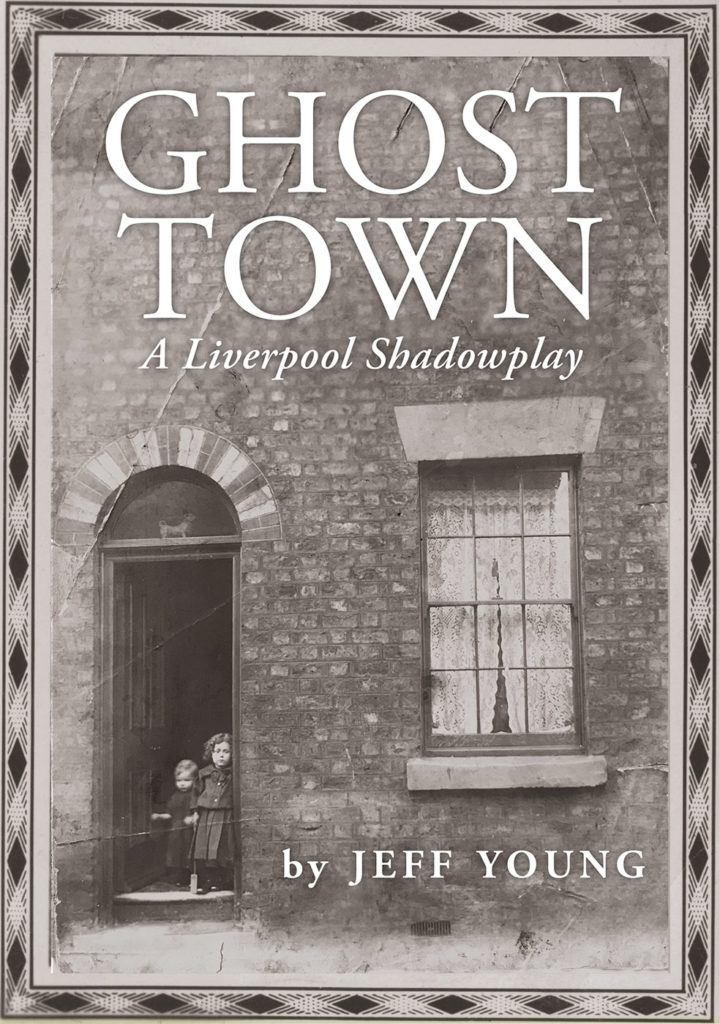Football terrace fashions, eccentric comedians, long-forgotten seedy nightclubs and thankfully not too much Beatles: Clinic’s Ade Blackburn assesses Jeff Young’s Ghost Town: A Liverpool Shadowplay – a conjuring of the city and its spectres, recently published by Little Toller.

‘The city is my muse; its unruliness and awkwardness, its rebellious spirit, its ugliness and beauty filter into the stories I write and make the work wayward and disruptive’.
Jeff Young delves deep into the Liverpool psyche and culture with Ghost Town: A Liverpool Shadowplay. From a childhood in the 1960s to the ghosts that haunt the memory in this century, the book dissects the past for an understanding of the present.
Young’s early years drew inspiration from exploring the local countryside – the hidden delights of fields, overgrown canal banks and dilapidated buildings. Much of this was soon bulldozed to make way for housing estates and motorways. His story reflects the obsession with progress at all costs; a seemingly inevitable slide from innocence and optimism to a greedy, no-values culture.
The writing conjures up the magic of a thriving 1960s Liverpool and how that gave way to the steep decline of the Thatcher years. The football terrace fashions, eccentric comedians and long-forgotten seedy nightclubs. The clubs include the infamous Rotters , which hosted surreal bluesman Captain Beefheart in 1980. Young neatly observes ‘Liverpool is a Beefheart city’, which is as succinct and accurate a description as I’ve seen.
The inspiration of Terence Davies’s 1988 Distant Voices, Still Lives film looms large over Ghost Town. The film documents the joy and heartbreak of Liverpool working class life in the middle of the last century – ‘When I first saw Davies’s Distant Voices, Still Lives I recognised my Liverpool immediately. I half expected to see my granddad, nana and my uncles spilling out onto the doorstep’.
Ghost Town feels like a continuation and conclusion of the film – sadly, an ending that the characters in the film couldn’t have envisaged, the communities they built now being torn apart.
The book also uncovers the bohemian and literary past of Liverpool. Stories and myths abound, with Bob Dylan, Jack Kerouac and renowned Mersey poet Adrian Henri all making an appearance. This highlights a lesser-known side of the city and one that Young emerged from with his own writing. Thankfully, there’s not too much Beatles either.
With the emergence of punk, he discovered Eric’s club on Matthew Street. The club was a melting pot of eccentric talent, with Echo and the Bunnymen, The Teardrop Explodes and Wah! Heat all emerging from Eric’s to become Top of the Pops regulars. Peter O’Halligan’s ‘Liverpool School of Art and Language’ was also a major hive of creativity and haunt of Young’s – an Arts Lab where anything seemed possible, and which doubled as a place to hangout for the city’s alternative misfits.
All of this is put into sharp relief by the events of the succeeding decades. Thatcher’s plan for managed decline ravaged the city. Once again, people were clinging to music and the arts as a way of escape. In the 2014 play Bright Phoenix, Young depicts the present as ‘Places closing down all the time – community centres, boozers, libraries, swimming baths. And once a building’s closed, it dies before your eyes’.
The loss of venues and cinemas in particular is well documented. With Bright Phoenix, Young had campaigned to keep The Futurist cinema on Lime Street open; the cinema was a favourite from his childhood. Sadly, the building was demolished in 2016, to make way for a new Lidl supermarket.
The Futurist acts as a symbol of different paths that could have been taken but were routinely ignored by the City Council. Their apparent ignorance and short-sightedness prompted the closure and demolition of many cultural landmarks. Astonishingly, this even went as far as demolishing The Cavern.
As an antidote to the heavy loss of places and people, we’re still able to enjoy an intact sense of wonder and romanticism – ‘I have tried to imbue a story with the melancholy of Liverpool’s psychedelic sunsets’. Ghost Town shows the ability of the human spirit to survive against monumental change. An evocation of a world fast disappearing but never forgotten.
*
You can read an extract from Ghost Town here.
Ghost Town is out now and available here in our shop, priced £16. Our shop platform, state51, is still accepting orders, but is working with a skeleton staff, and so orders may be delayed. We are most appreciative of your understanding and custom in this uncertain time. Alternatively, you can purchase through the publishers here.
Clinic’s latest album Wheeltappers and Shunters is out now via Domino.